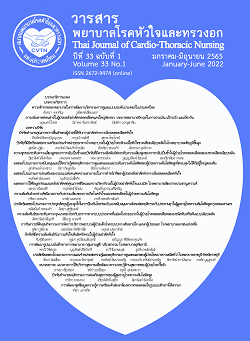ความชุกและความแตกต่างด้านเพศต่อการเกิดภาวะเลือดออกในผู้ป่วย โรคกล้ามเนื้อหัวใจขาดเลือดเฉียบพลันภายหลังเปิดขยายหลอดเลือดหัวใจผ่านสายสวน
คำสำคัญ:
โรคกล้ามเนื้อหัวใจขาดเลือดเฉียบพลัน, ภาวะเลือดออก, หัตถการเปิดขยายหลอดเลือดหัวใจผ่านสายสวนบทคัดย่อ
วัตถุประสงค์การศึกษาครั้งนี้เพื่อศึกษาความชุกและความแตกต่างด้านเพศต่อการเกิดภาวะเลือดออกในผู้ป่วยโรคกล้ามเนื้อหัวใจขาดเลือดเฉียบพลันภายหลังเปิดขยายหลอดเลือดหัวใจผ่านสายสวนขณะพักรักษาในโรงพยาบาล เก็บข้อมูลจากบันทึกทางสุขภาพของโรงพยาบาลระดับตติยภูมิแห่งหนึ่ง กลุ่มตัวอย่างจำนวน 375 ราย วิเคราะห์ข้อมูลทั่วไปด้วยสถิติ ความถี่ ร้อยละ และส่วนเบี่ยงเบนมาตรฐาน วิเคราะห์ความสัมพันธ์ใช้ไคสแควร์และการทดสอบของฟิชเชอร์ และใช้โลจิสติคทวิสำหรับการวิเคราะห์ปัจจัยเพศทำนายภาวะเลือดออก
ผลการวิจัย กลุ่มตัวอย่างส่วนใหญ่เป็นเพศชายร้อยละ 76.8 อายุเฉลี่ย 61.1±12.5 ปี มีภาวะเลือดออกร้อยละ 40.5 (95% CI: 0.44-.0.58) เพศชายและเพศหญิงมีภาวะเลือดออก ร้อยละ 38.5 (95%CI: 0.39-0.54) และ ร้อยละ 47.1 (95%CI: 0.47-0.79) ตามลำดับ ปัจจัยอายุ สถานที่อยู่ขณะที่เจ็บป่วย และภาวะช็อกมีความสัมพันธ์กับภาวะเลือดออกอย่างมีนัยสำคัญทางสถิติ (p= .000, .007, .008 ตามลำดับ) ปัจจัยด้านอายุมีความสัมพันธ์กับภาวะเลือดออกทั้งเพศหญิงและเพศชายอย่างมีนัยสำคัญทางสถิติ (p = .003, .019 ตามลำดับ) ภาวะช็อกมีความสัมพันธ์กับภาวะเลือดออกเฉพาะในเพศชายอย่างมีนัยสำคัญทางสถิติ (p-value= .008) เพศหญิงมีแนวโน้มเกิดภาวะเลือดออกมากกว่าเพศชาย (OR 1.421, 95%CI: 0.877-2.304, p= .154)
จากผลการศึกษาผู้ป่วยโรคกล้ามเนื้อหัวใจขาดเลือดเฉียบพลันภายหลังเปิดขยายหลอดเลือดหัวใจผ่านสายสวนที่เป็นเพศหญิง และ/หรือ อายุ > 50 ปี และ/หรือ เพศชายที่มีภาวะช็อก ควรเฝ้าระวังอย่างใกล้ชิดและดูแลเพื่อป้องกันภาวะเลือดออก ขณะพักรักษาในโรงพยาบาล
เอกสารอ้างอิง
Levine NG, Bates RE, Blankenship CJ, Bailey RS, Bittl AJ, Cercek B, et al. 2011 ACCF/AHA/SCAI guideline for percutaneous coronary intervention. J Am Coll Cardiol. 2011;58(24), 44-122.
Rao SV, McCoy LA, Spertus JA, Krone RJ, Singh M, Fitzgerald S, et al. An updated bleeding model to predict the risk of post-procedure bleeding among patients undergoing percutaneous coronary intervention: a report using an expanded bleeding definition from the national cardiovascular data registry CathPCI registry. JACC. 2013; 6(9):897-904.
Berlin G, Hammar M, Tapper L, Tynngard N. Effects of age, gender and menstrual cycle on platelet function ssessed by impedance aggregometry. Platelets. 2019;30(4):473-9.
Manoukian VS, Feit F, Mehran R, Voeltz DM, Ebrahimi R, Hamon M, et al. Impact of major bleeding on 30-Day mortality and clinical outcomes in patients with acute coronary syndromes. J Am Coll Cardiol. 2007;49(12):1362-8.
Nikolsky E, Mehran R, Dangas G, Fahy M, Na Y, Pocock JS, et al. Development and validation of a prognostic risk score for major bleeding in patients undergoing percutaneous coronary intervention via the femoral approach Eur Heart J. 2007;28(16):1936-45.
Numasawa Y, Kohsaka S, Ueda I, Miyata H, Sawano M, Kawamura A, et al. Incidence and predictors of bleeding complications after percutaneous coronary intervention. J Cardiol. 2016; 69:272–9.
Mehta SK, Frutkin AD, Lindsey JB, House JA, Spertus JA, Marso SP. Bleeding in patients undergoing percutaneous coronary intervention: The development of a clinical Risk algorithm from the national cardiovascular data registry. Circ Cardiovasc Interv. 2009;2(3):222-9.
Ahmed B, Piper WD, Malenka D, VerLee P, Robb J, Ryan T, et al. Significantly improved vascular complications among women undergoing percutaneous coronary intervention: a report from the Northern New England Percutaneous Coronary Intervention Registry. Circ Cardiovasc Interv. 2009; 2:423–9.
Bar J, Lahav J, Hod M, Ben-Rafael Z, Weinberger I, Brosens J. Regulation of platelet aggregation and adenosine triphosphate release in vitro by 17beta-estradiol and medroxyprogesterone acetate in postmenopausal women. Thromb Haemost. 2000;84(4):695-700.
Wu GJ, Lee JJ, Chou DS, Jayakumar T, Hsiao G, Chen WF, et al. Inhibitory signaling of 17beta-estradiol in platelet activation: the pivotal role of cyclic AMP-mediated nitric oxide synthase activation. Eur J Pharmacol. 2010;649:140–9.
Blanc JL, Lordkipanidze M. Platelet function in aging. Front Cardiovasc Med. 2019;6(109):18. doi:10.3389 /fcvm.2019.00109.
Nantasukhon A, Ausawakijpanich S, Siripittayakunkit A. A study of the patient’s vascular complications and pain after cardiac catheterization between transfemoral artery and transradial artery approach at post catheterization care unit, Ramathibodi hospital. Mahidol R2R e-Journal. 2019;6(2):42-53.
Patel RT, Lev EI, Vaduganathan M, Guthikondai S, Bergeron A, Maresh K, et al. Platelet reactivity among Asian Indians and Caucasians. Platelets. 2007;18(4):261-5.
Bain BJ. Ethnic and sex differences in the total and differential white cell count and platelet count. J Clin Pathol. 1996;49:964-6.
Geisler T, Schaeffeler E, Gawaz M, Schwab M. Genetic variation of platelet function and pharmacology: an update of current knowledge. Thromb Haemost. 2013;110.5: 876-87.
Zakai NA, Mcclure LA. Racial differences in venous thromboembolism. Thromb Haemost. 2011;9:1877-82.
Mehran R, Rao VS, Bhatt LD, Gibson MC, Caixeta A, Eikelboom J, et al. Standardized bleeding definitions for cardiovascular clinical trials: A consensus report from the bleeding academic research consortium. Circulation. 2011;123(23):2736-47.
Baber U, Mehran R, Giustino G, Cohen JD, Henry DT, Sartori S, et al. Coronary thrombosis and major bleeding after percutaneous coronary intervention with drug eluting tent. J Am Coll Cardiol. 2016;67:2224-34.
Genereux P, Giustino G, Witzenbichler B, Weisz G, Stuckey TD, Rinaldi MJ, et al. Incidence predictor and impact of post-discharge bleeding after percutaneous coronary intervention. J Am Coll Cardiol. 2015;66(9):1036-45.
Kwok SC, Rao VS, Myint KP, Keavney B, Nolan J, Ludman FP, et al. Major bleeding after percutaneous coronary intervention and risk of subsequent mortality: A systemic review and meta-analysis. Openheart. 2014;1(1),1-12.
Suh J, Mehran R, Claessen EB, Xu K, Baber U, Dangas G, et al. Impact of in-hospital major bleeding on late clinical outcomes after primary percutaneous coronary intervention in acute myocardial infarction the horizons-Ami (harmonizing outcomes with revascularization and stents in acute myocardial infarction) trial. Impact of in-hospital major bleeding on late clinical outcomes after primary percutaneous coronary intervention in acute myocardial infarction. J Am Coll Cardiol. 2011;58(17), 1750-6.
Peeyananjarassri K, Cheewadhanaraks S, Hubbard M, Zoa Manga R, Manocha R, Eden J. Menopausal symptoms in a hospital-based sample of women in southern Thailand. Climacteric. 2006 Feb;9(1):23-9.
Neumann F, Sousa-Uva M, Ahlsson A, Alfonso F, Banning PA, Benedetto U, et al. 2018 ESC/EACTS guidelines on myocardial revascularization. Eur Heart J. 2019;40(2):87–165.
ดาวน์โหลด
เผยแพร่แล้ว
รูปแบบการอ้างอิง
ฉบับ
ประเภทบทความ
สัญญาอนุญาต
ลิขสิทธิ์ (c) 2022 วารสารพยาบาลโรคหัวใจและทรวงอก

อนุญาตภายใต้เงื่อนไข Creative Commons Attribution-NonCommercial-NoDerivatives 4.0 International License.
บทความนี้ยังไม่เคยตีพิมพ์หรืออยู่ในระหว่างส่งไปตีพิมพ์ในวารสารอื่น ๆ มาก่อน และกองบรรณาธิการขอสงวนสิทธิ์ในการตรวจทาน และแก้ไขต้นฉบับตามเกณฑ์ของวารสาร ในกรณีที่เรื่องของท่านได้ได้รับการตีพิมพ์ในวารสารฉบับนี้ถือว่าเป็น ลิขสิทธิ์ของวารสารพยาบาลโรคหัวใจและทรวงอก






